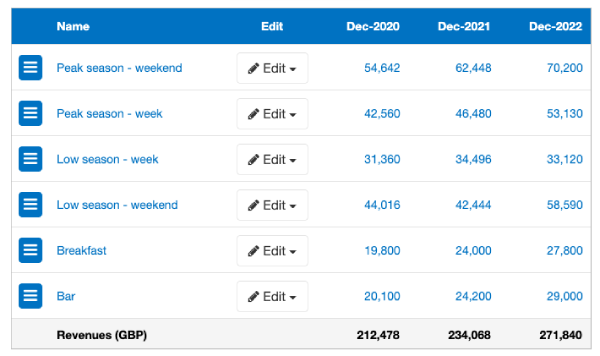
The cash flow statement is divided into operating, investing, and financing activities, linking cash flow with balance sheet changes and net income. Begin by defining the assumptions and drivers that will influence the model. These include growth rates, cost structures, working capital requirements, tax rates, and other factors impacting each financial statement.
Financial forecast: Process
In such cases, more frequent forecasting may be necessary to accurately capture and anticipate seasonal patterns. This model can be handy when you want to evaluate a new opportunity and have no historical data to base your predictions on. In this article, we’ll have a closer look at five different forecasting methods and present examples of use cases. Adopting this approach provides you with invaluable insights into your subscription-based business, helping you calculate costs, improve budgeting, and allocate resources. The problem has long been that manual data aggregation, reconciliation, and spreadsheet-based modeling can be so time-consuming that you have little time left to generate strategic insights. Your entire team — from the CFO all the way to the newest financial analyst — should be able to lean on automation to help shift the focus from low-value tasks to high-value strategic partnerships.
Inventory Count, an Inventory Management Tool: Importance and Tips
For example, new technologies are constantly changing operations across almost all industries at a fundamental level. To management, they indicate how well the company is actually doing and how much potential it financial forecasting examples has for expansion. Financial statements are not only for compliance purposes; they are also tactical tools. They let us know if we’re profitable, financially solid, and monetarily stable enough to stay afloat.
What is Financial Forecasting? Methods and Examples
They are based on pro-forma financial statements—the Income Statement, Balance Sheet, and Cash Flow Statement—with projected future financial data and assumptions based on past performance. Financial forecasting is predicting a company’s financial future by examining historical performance data, such as revenue, cash flow, expenses, or sales. This involves guesswork and assumptions, as many unforeseen factors can influence business performance. Income forecasting entails analyzing the company’s past revenue performance and current growth rate to estimate future income. Additionally, the company’s investors, suppliers, and other concerned third parties use this data to make crucial decisions. For example, suppliers use it when determining how much to credit the company in supplies.
It uses a linear relationship between independent and dependent variables to create a trend line. Use one of these profit and loss (P&L) templates to systematically track income and expenses, giving you a clear picture of your company’s profitability over a specific period. Use one of these discounted cash-flow (DCF) templates to evaluate the profitability of investments or projects by calculating their present value based on future cash flows. Use one of these cash-flow statement templates to track the movement of cash in and out of your business, so you can assess your company’s level of liquidity and financial stability.
Cash flow
Let us understand the concept of using financial forecasting techniques with the help of a couple of examples. These examples will give us a practical understanding of the concept and its intricacies. Sage Intacct separates itself from similar applications through its accessibility and room for collaboration. The software is particularly user-friendly and offers a singular, centralized solution for virtually any stakeholder within an organization to easily contribute to and make sense of financial projections. And it doesn’t have to be a tedious task to analyze your financial data, thankfully there’s plenty of forecasting, decision-making and financial-planning tools available for this purpose.
Remember, the goal is to create a realistic, useful forecast—without breaking the bank or eating up all your time. Get free guides, articles, tools and calculators to help you navigate the financial side of your business with ease. Bench simplifies your small business accounting by combining intuitive software that automates the busywork with real, professional human support.
- Understand the forecasting techniques for projecting revenues, expenses, capital expenditures, and working capital requirements.
- When you make a financial forecast, you see what direction your business is headed in, based on past performance and other factors, and use that to anticipate the future.
- He is also an International Business student at Rotterdam Business School where he focusses on analyzing and developing management models.
- Investors trade stocks, invest in funds, or rashly exit the market based on predictions about stock prices, interest rates, or broader market moves.
- An integrated financial model combines the income statement, balance sheet, and cash flow statement into a single dynamic framework.
- Quantitative forecasts use analyses of large quantities of historical data to identify trends and patterns.
The benefit of research-based forecasting is that you get a detailed, nuanced view of how your business could grow, taking into account a lot of different factors. Historical forecasting is a good bet if you’re forecasting for modest growth, or else creating a quick-and-dirty forecast for your own use—not putting together a presentation for potential investors. The benefit of this is that it’s relatively easy to do and doesn’t take a lot of time, money, or expertise. The drawback is that you’re only using info about your own business, and not looking at broader market trends—like what your competition has been up to. When you use your financial history to plot the future, it’s historical forecasting. You’re looking at your last few annual Income Statements, Cash Flow Statements, and Balance Sheets to see how fast you’ve grown in the past.
Additionally, practice scenario and sensitivity analysis to assess the impact of different variables on financial outcomes, aiding in investment decision-making and risk assessment. Financial forecasting is a method of prediction that a company makes and prepares for the future. It involves a possible outcome of the future by determining its current financial statements and performance, whereas financial modeling is the action taken on financial forecasting. Once the forecast assumptions are developed, and numbers are calculated using a financial statement, financial modeling comes into the picture. Financial modeling builds a predictive operating model to help a company in making sound business decisions. These financial models are mathematical models where different variables are linked together.
The CEOs of large companies aren’t going to take a phone call from a retail investor or show them around a facility. However, you can still sift through news reports and the text included in companies’ filings to get a sense of managers’ records, strategies, and philosophies. These techniques are especially valuable in situations where historical data is limited or in a period where previous data is unreliable since the market is changing. Techniques like moving averages and exponential smoothing help level out fluctuations to highlight underlying trends, making it easier to predict future values. In addition, time series forecasts often involve trend and cyclical fluctuation analysis.

Statistical models (also called quantitative forecasting models) create relationships between the findings of other disciplines. This approach often uses Gaussian distribution analysis to fit financial inputs and attempts into a classic standard distribution curve. Your team’s financial modeling (and, by extension, financial analysis) is only as effective as their ability to keep pace with business demand. Building a beautiful model doesn’t mean anything if it takes so long that the outputs you share with business partners are stale. The model uses time-based cohorts to show how total bookings waterfall out to GAAP revenue on a month-to-month basis.

Leave A Comment